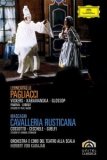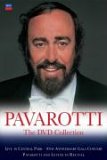 Herbert Von Karajan - Leoncavallo - I Pagliacci/Mascagni - Cavalleria Rusticana | DVD | (21/01/2008)
from £13.28
| Saving you £0.71 (5.35%)
| RRP
Herbert Von Karajan - Leoncavallo - I Pagliacci/Mascagni - Cavalleria Rusticana | DVD | (21/01/2008)
from £13.28
| Saving you £0.71 (5.35%)
| RRP Track Listings: 1. Preludio 2. O Lola Ch'ai Di Latti La Cammisa (Siciliana) 3. Introduzione 4. Gli Aranci Olezzano Sui Verdi Margini 5. Dite Mamma Lucia 6. Il Cavallo Scalpita 7. Beato Voi Compar Alfio 8. Perch'' M'hai Fatto...Voi Lo Sapete 9. Tu Qui Santuzza? 10. No No Turiddu Rimani 11. Oh! Il Signore Vi Manda (Duetto) 12. Intermezzo Sinfonico 13. A Casa A Casa Amici ...Comare Lola 14. Viva Il Vino Spumeggiante (Brindisi) 15. A Voi Tutti Salute! 16. Mamma Quel Vino ''ˆ Generoso 17. Opening Credits / Pagliacci / Karajan 18. Introduction 19. Si Pu''? Signore! Signori! 20. Son Qua! Ritornano 21. Un Grande Spettacolo! 22. Un Tal Gioco Credetemi 23. Don Din Don - Suona Vespero 24. Qual Fiamma Aveva Nel Guardo! 25. Sei L'' - So Ben Che Difforme - Oh! Lasciami 26. Nedda! Silvio A Quest'ora 27. E Allor Perch'' Di' Tu M'hai Stregato 28. Cammina Adagio - Derisione E Scherno! - Padron! Che Fate! 29. Recitar! - Vesti La Giubba 30. Intermezzo 31. Presto Affrettiamoci 32. Pagliaccio Mio Marito 33. E Dessa! Dei Come ''ˆ Bella 34. Arlecchin! Colombina! - Prendi Questo Narcotico 35. Coraggio 36. No Pagliaccio Non Son
![Puccini: Madama Butterfly -- Verona/Arena [1983]](/pictures/1028667.jpg) Puccini: Madama Butterfly -- Verona/Arena | DVD | (11/06/2001)
from £13.56
| Saving you £6.19 (52.46%)
| RRP
Puccini: Madama Butterfly -- Verona/Arena | DVD | (11/06/2001)
from £13.56
| Saving you £6.19 (52.46%)
| RRP This traditional production of Puccini's enduringly popular opera Madama Butterfly should give much pleasure. It was recorded at the open-air theatre in Verona in 1983 with the local orchestra and chorus under the aptly named Maurizio Arena. The video direction is by an expert in the field, Brian Large, who brings home all the intimate moments of Puccini's drama from an open set that ascends and sprawls across rows of seating. His camera draws the viewer into scenes that the audience cannot witness at their distance--most movingly when Sharpless, the American consul in Nagasaki, gives up his attempt to read Pinkerton's letter to Butterfly saying he has no intention of seeing her again (set to that magical melody which will recur as the humming chorus). It's of little matter that there are no operatic stars in the cast for this ensemble consists of experienced singers who fill the night air with lungs to match Puccini's heaviest demands. The audience, many of them evidently on holiday, greet the show-stopping moments with waves of applause. Their enthusiasm may drown a few bars of orchestral continuity but the orchestra itself is always at the service of the singers on a soundtrack that captures the atmosphere of an open-air performance with astonishing verisimilitude. Butterfly, sung by the statuesque Raina Kabaivanska, may not see Cio-Cio San (to give "butterfly" her real name) 16 years again and some of her arm movements are overdone but her big number "Un bel di" and its reprise when she's holding her child by Pinkerton are touchingly conveyed. Neither does she overplay the final scene where she prepares to follow her father's example using the Mikado's dagger to commit suicide--a moment that sends a shiver down the spine in its economy. Nazzareno Antinori as her Pinkerton, with his matinée idol looks and resonant voice, complements her well; their singing of Puccini's spacious love duet at the close of Act One goes down a treat with the crowd. --Adrian Edwards
![Tosca - Puccini [1976]](/pictures/1027920.jpg) Tosca - Puccini | DVD | (09/05/2005)
from £16.05
| Saving you £0.94 (5.86%)
| RRP
Tosca - Puccini | DVD | (09/05/2005)
from £16.05
| Saving you £0.94 (5.86%)
| RRP Opera is an inherently theatrical medium that does not lend itself readily to the realism of film treatment. The shining exception is Puccini's Tosca, an action-packed melodrama that unfolds in three taut and gripping acts, like the meatiest of Hollywood films noir. And unlike most operas, these three acts are set in three very specific Roman locales. Thus this 1976 film takes place in the church of Sant'Andrea della Valle (Act 1), the Palazzo Farnese (Act 2) and the Castel Sant'Angelo (Act 3). The evocative settings, however, would be mere window-dressing if the cast wasn't just right; fortunately here Placido Domingo is at his virile peak in the heroic tenor role of Cavaradossi; Raina Kabaivanska is a sultry, vocally beautiful Tosca; while a more infamous and domineering Scarpia than that of Sherrill Milnes can hardly be imagined. Bruno Bartoletti and the New Philharmonia Orchestra give lustily dramatic support. Here the music and vocals are pre-recorded and the singers mime to the playback. Occasionally the result is a little unnatural, but overall the cast are good enough actors to bring off the conceit even in the close-ups. It all pays off triumphantly with the gripping realism of the rooftop finale, the one place where film can improve on stage. With the authenticity of the settings assured and such distinguished leads singing so well, this is an almost ideal filmed Tosca. On the DVD: Tosca on disc is presented in 4:3 ratio with a choice of Dolby 5.1 or LPCM Stereo. The picture is adequate but a little flat (possibly because the format is NTSC not PAL) and the same can be said for the sound, which does what it should but is never revelatory. Subtitles are provided in the main European languages and Chinese. --Mark Walker
![Il Trovatore - Verdi [1978]](/pictures/1028081.jpg) Il Trovatore - Verdi | DVD | (24/09/2004)
from £7.76
| Saving you £23.49 (361.38%)
| RRP
Il Trovatore - Verdi | DVD | (24/09/2004)
from £7.76
| Saving you £23.49 (361.38%)
| RRP Recording of the Verdi opera from the Wiener Staatsoper in 1978 with Herbert von Karajan conducting.
![Gabrielle [2005]](/pictures/1067464.jpg) Gabrielle | DVD | (23/04/2007)
from £N/A
| Saving you £N/A (N/A%)
| RRP
Gabrielle | DVD | (23/04/2007)
from £N/A
| Saving you £N/A (N/A%)
| RRP Gabrielle is Patrice Chreau's stunning adaptation of the short story ""The Return"" by Joseph Conrad. Recreating turn-of-the-century France with superb attention to detail Chreau casts an unrelenting gaze on the marital breakdown that overwhelms a middle-aged bourgeois couple played with chilling precision by Isabelle Huppert and Pascal Greggory. As wealthy Parisian Mr. Hervey (Greggory) descends from a train into the teeming bustle of the city. While on his way home he reflects on the sturdiness and success of his life and the fortress of security he has built around himself. It is not long before his self-satisfaction is rudely shattered when he discovers a letter from his wife Gabrielle (Huppert) waiting for him on his sideboard. The contents of the message will crumble that security and plunge him into newfound feelings of vulnerability abandonment and betrayal. The couple soon finds themselves engaged in a parry-and-thrust of emotions that change mid-sentence and stretch their ability to function and live in the same house.
 Puccini: Tosca -- 1976 film version | DVD | (15/10/2001)
from £N/A
| Saving you £N/A (N/A%)
| RRP
Puccini: Tosca -- 1976 film version | DVD | (15/10/2001)
from £N/A
| Saving you £N/A (N/A%)
| RRP Opera is an inherently theatrical medium that does not lend itself readily to the realism of film treatment. The shining exception is Puccini's Tosca, an action-packed melodrama that unfolds in three taut and gripping acts, like the meatiest of Hollywood films noir. And unlike most operas, these three acts are set in three very specific Roman locales. Thus this 1976 film takes place in the church of Sant'Andrea della Valle (Act 1), the Palazzo Farnese (Act 2) and the Castel Sant'Angelo (Act 3). The evocative settings, however, would be mere window-dressing if the cast wasn't just right; fortunately here Placido Domingo is at his virile peak in the heroic tenor role of Cavaradossi; Raina Kabaivanska is a sultry, vocally beautiful Tosca; while a more infamous and domineering Scarpia than that of Sherrill Milnes can hardly be imagined. Bruno Bartoletti and the New Philharmonia Orchestra give lustily dramatic support. Here the music and vocals are pre-recorded and the singers mime to the playback. Occasionally the result is a little unnatural, but overall the cast are good enough actors to bring off the conceit even in the close-ups. It all pays off triumphantly with the gripping realism of the rooftop finale, the one place where film can improve on stage. With the authenticity of the settings assured and such distinguished leads singing so well, this is an almost ideal filmed Tosca. On the DVD: Tosca on disc is presented in 4:3 ratio with a choice of Dolby 5.1 or LPCM Stereo. The picture is adequate but a little flat (possibly because the format is NTSC not PAL) and the same can be said for the sound, which does what it should but is never revelatory. Subtitles are provided in the main European languages and Chinese. --Mark Walker
 Verdi - Falstaff / Taddei, Kabaivanska, Panerai, Araiza, Ludwig, Perry, Schmidt, Karajan, Salzburg (1991) | DVD | (10/06/2002)
from £20.00
| Saving you £-5.01 (N/A%)
| RRP
Verdi - Falstaff / Taddei, Kabaivanska, Panerai, Araiza, Ludwig, Perry, Schmidt, Karajan, Salzburg (1991) | DVD | (10/06/2002)
from £20.00
| Saving you £-5.01 (N/A%)
| RRP A Salzburg Festival performance of Verdi's opera Falstaff by the Vienna Philharmonic Orchestra and the Vienna Konzertvereinigung State Opera Choir, conducted by Herbert Von Karajan. Singers include: Taddei, Panerai, Ludwig, Perry and Kabaivanska.
 Luciano Pavarotti - The DVD Collection | DVD | (13/09/2004)
from £N/A
| Saving you £N/A (N/A%)
| RRP
Luciano Pavarotti - The DVD Collection | DVD | (13/09/2004)
from £N/A
| Saving you £N/A (N/A%)
| RRP Three features including 'Pavarotti In Central Park' 'Pavarotti - A 30th Anniversary Gala Concert' and 'Pavarotti And Levine In Recital'. Pavarotti - Live In Central Park: One of the three most famous tenors in the world the exceedingly round Luciano Pavarotti has a voice that could shake all of New York City. And it surely shook all of Central Park on the night that the star performed in 1993. As captured on this video Pavarotti is ably backed by members of the New York

Please wait. Loading...
This site uses cookies.
More details in our privacy policy